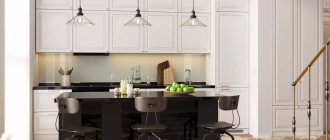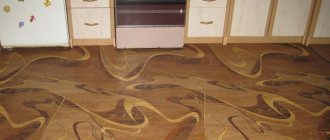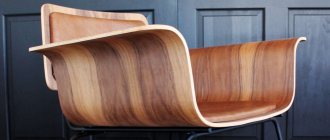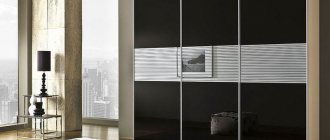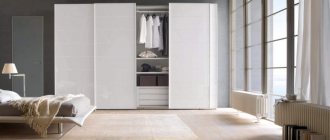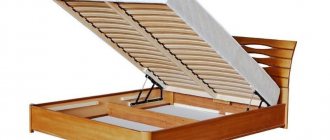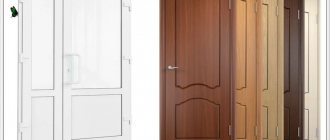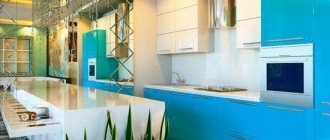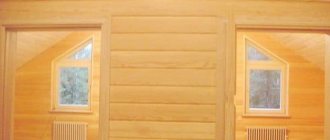What is chipboard lamination and how to laminate furniture at home: Review + Video
Furniture lamination is the process of applying a special film or paper to the material, after which its appearance becomes more expensive and elegant. Furniture made from chipboard is subject to lamination - a cheap and therefore in-demand building material that is quite durable, but does not look very presentable.
It allows you to make repairs economically, and laminating furniture at home will smooth out all the shortcomings of the slab and will be a practical, non-wasteful solution.
- Main questions
- How to laminate chipboard with your own hands
- Process
- Which laminating film should I choose?
- Preparation for lamination
- Other methods of processing furniture
Main questions
What is "chipboard"?
Chipboard stands for “chipboard.” From the name you can understand that this is not a separate type of wood, but a mixture of wood shavings, held together with glue and placed under a press. This material is inexpensive and is used instead of scarce wood, it is easy to work with and durable, which is what arouses interest. Thanks to modern decorating techniques, chipboard will become a worthy replacement for expensive wood, the extraction of which, moreover, causes enormous harm to our environment.
ADVICE! Laminated chipboard can be immediately purchased at the factory, it can be made to order, but you can independently process a regular pressed board using laminating agents.
Why laminate chipboard?
Looking at a product made from chipboard, it becomes clear why it is recommended to laminate the raw material. Firstly, it does not look very beautiful, its decorative qualities leave much to be desired. Secondly, lamination will smooth the surface, make it more pleasant to the touch and help avoid the danger of splinters, scratches or snags on thin fabric. Thirdly, the procedure will significantly improve the quality of the product, making it more moisture resistant, which is very useful for kitchen furniture.
How to laminate chipboard with your own hands
Process
Laminating chipboard at home involves applying a special film to the surface.
ATTENTION! It is impossible to reproduce the perfect finishing of furniture at home. Factories immediately produce furniture made from laminated chipboard (chipboard), the quality of which will be better and the service life will be longer, with the remaining savings.
There are several ways to laminate furniture at home:
- — Application of self-adhesive film to the surface. Simply remove the layer of protective paper and carefully apply it to the furniture. After the film has stuck, remove air bubbles with a plastic spatula or cloth.
- — Gluing the film with glue. Universal adhesive is applied to the slab and left for a while, after which a film is applied to it. For high-quality gluing, it is recommended to roll it over and hold it under pressure.
BE CAREFUL! When applying the film, carefully measure the shape and surface area, because if you apply the laminate material crookedly, it will be impossible to reuse it - re-glue it.
Which laminating film should I choose?
For lamination of chipboards, several types of films have been developed, which differ in their properties, composition and cost:
- — Phenolic film. Its properties include increasing the wear resistance of materials in terms of mechanical damage, but also having a low moisture resistance.
- — PVC (Polyvinyl chloride). The functionality of this film is aimed at improving the water resistance of furniture.
- — Melamine film. Its properties include wear resistance and moisture resistance, however, the membrane contains formaldehyde resin, which can cause some damage to health when heated. This product should be used outdoors. Cooled material is not hazardous.
Preparation for lamination
Before applying film to furniture, you need to prepare it for the procedure:
1) First we sand the product. This can also be done with sandpaper - if it is not large in size, or, if it is large in size - with a grinder. Sand until the furniture walls are smooth.
2) Then it is recommended to putty the chipboard, dry it and go over it again with less sandpaper.
IMPORTANT! The smoother the surface, the more accurately the film will sit.
3) Next, the workpiece is treated with a wood primer and dried.
4) It is necessary to cut the film, adjusting it according to the details - take into account the height, width, shape and corners of the furniture.
5) Next, proceed to gluing the film: having freed part of the protective layer, apply it to the surface of the furniture and gradually move along it.
Melamine film for chipboard cladding.
Melamine films are a modern facing material based on decorative papers of various densities (plain or printed), impregnated with amino-formaldehyde resins with an incomplete degree of polycondensation. (photo from website: bimma.ru)
To obtain a melamine film, you need to impregnate special decorative paper with resin. Impregnation occurs in several stages. On an impregnation machine, resin is first applied with a roller to the underside of the canvas, and then the paper is completely immersed in the resin in the bath. Between the first and second stages of impregnation, the paper passes through a “penetration” zone. As this zone passes through, the resin applied to the underside penetrates the paper and displaces the air from the paper. Thanks to the displacement of air, good saturation of the middle of the paper is achieved in the future.
After the first impregnation machine, the paper is dried, resulting in the removal of volatile substances. Then the fabric enters the second impregnation machine. There, a layer of melamine-formaldehyde resin is applied to both sides of the paper sheet. The purpose of applying a second layer of resin is to give the top layer increased fluidity properties during pressing, as well as to give the facing surface smoothness and increased strength.
The paper then goes into another dryer, which has three heating zones and one cooling zone. Once in the cooling zone, the film sheet enters a roller conveyor (roller table), the rollers of which are cooled by water. This is how paper turns into film. After this, the film is cut into sheets of a given size. These film sheets are stacked on a sheet stacker and packaged.
Source: www.makuha.ru
Other methods of processing furniture
In addition to simply applying film to glue or gluing self-adhesive tape, there are several other methods for processing chipboard furniture:
- — Laminating. In this method, glue is applied to the product, and then a thermal film of a polymer composition is applied.
- — Veneering. Veneer is a very thin layer of high-quality wood, if natural, if synthetic - paper canvas with imitation of wood patterns. Using molten resins, such material is welded to the base under the influence of high temperatures.
Thus, laminating furniture at home is quite easy and the quality depends solely on your efforts.
How to laminate chipboard at home?
Share on social media networks:
- Features of obtaining laminated chipboard
- Do-it-yourself methods for laminating chipboard
- How to laminate chipboard at home: laminating technology
- Selecting lamination film
- Video material
Chipboard is one of the most inexpensive materials, which is still not abandoned in the manufacture of furniture. In general, with proper design, interior items look like a worthy imitation of natural wood and add their own flavor to the overall style. But ordinary chipboard is not suitable for this purpose. The plate looks unpresentable. In addition, there is a risk of getting splinters if you carelessly touch the edge. About 40 years ago, a technology for producing decorative surfaces using lamination was developed. Let's take a closer look at how to laminate chipboard with your own hands at home.
Features of obtaining laminated chipboard
Chipboard (chipboard) is used for the manufacture of furniture in the “medium” and “economy” classes. If the surface is covered with a decorative and protective material, then we are talking about laminated chipboard (LDSP).
For cladding laminated chipboards the following is used:
- The plastic is laminated paper, impregnated with a resin composition.
- Paper film impregnated with synthetic thermosetting resins.
When producing chipboard in a factory, a conveyor or short-cycle belt press is used. Under conditions of high pressure and temperature, the resin spreads over the surface and forms a durable, solid web.
How to choose coffee sets for the garden?Features of purchasing custom-made kitchen furniture
- Choosing the perfect sofa
Important! Modern equipment used in enterprises makes it possible to achieve a realistic imitation of the texture of wood, textiles, and ornamental stone. Laminated chipboard is produced with a glossy, embossed surface, as well as with a 3D effect.
Alternative technologies:
- Another technology for decorating chipboard is often confused with the lamination process: lamination. In classic lamination, the resin is melted and then pressed. Laminating involves gluing. An adhesive is applied to the base, then a polymer thermoplastic film or laminated paper is applied.
Important! This material is less durable and can swell and deform. As for the laminated board, it is a single inseparable whole.
- There is another technology reminiscent of lamination - veneering. Veneer is the thinnest layer of noble wood. The veneer thickness is from 2 mm. Gluing to the veneer surface is carried out using adhesive compounds: one- or two-component.
Important! The surface doesn't just look beautiful. It is truly unique, since the natural grain of the wood is preserved. Veneer is quite demanding to maintain. It can be painted, varnished, impregnated or waxed. If the coating comes off, experts recommend using universal or carpenter's adhesive.
- Sometimes you can find such a definition as synthetic veneer. This is a paper canvas with a texture that imitates the unevenness of wood, impregnated with urea resin. Sometimes the surface is varnished.
Important! The material is durable, hard, and feels identical to wood veneer.
Lamination, therefore, is a technology of “welding” decorated paper to a base using synthetic molten resins. The resulting surface is resistant to high temperatures, moisture and mechanical stress.
Types and uses of laminated MDF - Finishing
Surely everyone has heard about such a thing as decorative processing of materials. One of these types is laminated MDF. Currently, it is often used in many areas of production, for example, in the manufacture of doors, furniture, etc.
What is lamination? This is a type of decorative processing of slabs. It is intended to decorate the product, and also helps to improve the technical and operational properties of the material. Laminated MDF panel has deservedly taken a leading position among other building materials.
Laminated MDF: general concept
MDF boards are more modern and high-tech products compared to their predecessors. In their manufacturing process, only modernized technologies are now used. The basis of such material is wood processing waste. As well as non-commercial wood, which due to its low quality is not suitable for high-quality products.
The appearance of this material allows you to significantly refine the products, giving them luxury and richness. A striking example of this are laminated MDF doors.
Manufacturing technology of laminated MDF
The MDF production process is as follows. Special chipping machines grind all raw materials into chips.
Next, the resulting mass is doused with hot steam under high pressure, which makes the material much softer. After this, the workpieces are brought to a certain consistency.
During this process, lingin (a natural binding substance) is released from the wood fibers. The last stage is drying, pressing and gluing.
In order for the finished product to become laminated, its front surface is subjected to additional processing. Why is this process necessary? Lamination is performed in order to give the material additional properties, that is, to make it as resistant to moisture and various types of wear as possible.
Pursuing this goal, a paper-resin or melamine film, which contains a special astringent composition, can be applied to the sheet. After this, the MDF is subjected to heat treatment. Such technological influence leads to certain chemical reactions. Thanks to them, the composition located on the surface films impregnates the sheet.
When polymerization of the resin begins, which forms the surface layer (it does not separate from the finished product), laminated MDF is obtained.
As for the technical characteristics of this material, thanks to modern technology it is extremely resistant to high humidity and the effects of various chemicals. It is the laminated layer that prevents the growth of any kind of fungus or mold.
Advantages and disadvantages of MDF
It is clear that each material has its pros and cons. Laminated MDF is no exception. Among its main advantages, it is worth highlighting its hygiene, reasonable cost, especially in comparison with natural wood, and environmental friendliness.
In addition, this material has high sound and heat insulation properties. A wide range of color solutions allows you to implement different design ideas.
And finally, the most important advantage is simple assembly; installing laminated MDF is quite easy, you don’t need to have any special skills for this.
As for the downsides, there are few of them. The low level of fire resistance and the relatively large weight of the slabs deserve special attention. This may pose some restrictions on the use of this material. It is also worth noting that when exposed to high temperatures, the top layer of MDF peels off.
Cost of laminated MDF panels
Despite the fact that laminated MDF has excellent mechanical and performance characteristics, its price is not that high when compared with other natural wood products.
The special process of MDF production, during which it is customary to use non-profitable wood (with a low input price) or wood waste, has a significant impact on the formation of costs.
This material differs in thickness and size, which, in turn, are displayed in monetary terms.
Laminated MDF (price starts from 300 rubles and above) can be purchased at any specialized store.
Source:
Laminated MDF (LMDF boards)
» New trends in finishing » Laminated MDF (LMDF boards)
Brief characteristics of MDF
Medium Density Fiberboard, or MDF, is a board made from fine-grained shavings of industrial wood.
The raw materials are ground practically into dust, mixed with polymer resins and put into a special heat-pressing unit.
The resulting material is similar in some respects to fiberboard, but unlike the latter, it has better characteristics in terms of basic indicators:
- Slab density – 400-750 kg/m3;
- Bending strength – up to 23 MPa;
- Modulus of elasticity during static bending – up to 1700 MPa;
- The level of formaldehyde release is E0-E1 (up to 10 mg per 100 g of dry matter);
- Humidity – no more than 10% of weight.
Mechanically, MDF is much stronger and easier to work with. This is the only material among its analogues, the surface of which can be processed with a milling cutter, cut out shaped elements and form bent parts. Such operations are impossible with either chipboard or OSB.
In addition, MDF has the following set of advantages:
- Long service life.
- Low level of thermal conductivity.
- Possibility of using various types of processing and finishing (painting, varnishing, laminating, postforming and much more)
- Moisture resistance (not to be confused with water resistance).
- Hygiene.
- Low price.
Since the products, in the language of designers, are very plastic and easy to process, the lamination technique is widely used for surface finishing. Plastic film or paper impregnated with melamine resins is glued to the front side. The resulting sheets are called “laminated MDF” (LMDF).
“Semi-finished” slabs are produced in a wide range of sizes:
- Length - up to 6 m;
- Width – from 0.1 to 3.75 m;
- Thickness – 3-40 mm.
Features of LMFD
MDF boards undergo a lamination process not only to protect the surface from scratches, water and other negative factors. the purpose is decorative. Modern high-precision laser printing technologies make it possible to create any image with a perfectly executed depiction of any small detail. For example, this could be the texture of wood, the pores of brick, etc.
We recommend: Glass tiles for interior walls and floors
All this allows you to get a pattern on the MDF surface that imitates the color and structure of natural wood, natural stone, porcelain stoneware or tiles, textiles, leather, metal and much more. Various effects and techniques are used: aging, matting, patination, rustication, brushing, etching, etc.
Each manufacturer (Kronostar, Kronospan, Egger, KZMDF, etc.) develops its own line of designs, including:
- traditional wood decors (beech, oak, cherry, walnut);
- certain exotic wood species (jatoba, zebrawood, kempas, panga-panga);
- imitation stone surface (tiles, marble, limestone, granite, concrete);
- monochrome pastel, less often bright colors (vanilla, orange, saffron);
- metallized decors;
- non-standard (abstract combinations of shades, geometric shapes, thematic designs).
Thus, LMDF has a presentable appearance and a leading number of decors. Every year the range is replenished with new designs.
The sheets are quite durable, but, nevertheless, they must be properly transported and protected from atmospheric phenomena (precipitation, wind, direct sunlight) and mechanical damage. Storage and operation of products is carried out at an average temperature of +15 to +25 ° C and a relative air humidity of no more than 70%.
Do-it-yourself methods for laminating chipboard
Of course, it is impossible to accurately reproduce the factory process of chipboard lamination with your own hands. If only because you have neither professional skills nor specialized equipment. In addition, the compositions used for industrial lamination contain toxic substances.
The best option is laminating:
- Chipboard cladding using self-adhesive film. This is a dense canvas made of synthetic material with an adhesive applied to the reverse side.
Important! It is enough to remove the layer of protective paper and glue the film to the surface. Air bubbles can be removed with a plastic spatula or soft cloth.
- Gluing a film of polymer material using universal glue. The glue is applied to the chipboard and left for a short time. Then the film is carefully glued. For better adhesion, it is rolled with a roller or pressed with a press.
Important! Of the two options given, the second one is more reliable. As practice shows, self-adhesive tape has to be re-glued periodically or a new one must be purchased. The savings are quite dubious. The best option is to purchase chipboard with industrial lamination.
- Upholstered furniture in Perm
Beds with soft panels at the head: stylish solution and comfort
- Ideas for arranging furniture in a small room
How to laminate the surface?
To laminate a plywood sheet yourself, you will need the following tools:
Before gluing the protective layer to the plywood, it should be warmed up thoroughly with a hairdryer, but the temperature should not be overdone, otherwise bubbles will form on the surface. As the film is glued, the treated areas are ironed with a rag to expel air from under the polymer layer. If bubbles form, you can pierce them with a needle, then heat them again with a hairdryer and smooth them out. The lamination process is demonstrated in more detail in the video, where experts tell and show how a protective film can be applied to the coating.
Conclusion
To laminate plywood yourself, you will need skill or an extra “pair of hands.” If you have not dealt with a similar procedure, it is advisable to have someone assist you. This way you will be able to avoid many mistakes and prevent air bubbles from appearing under the protective layer.
Source: thefanera.ru
How to laminate chipboard at home: laminating technology
This part of the article is dedicated to stubborn people who are used to doing everything on their own. So, the procedure for gluing a chipboard board with a synthetic film is as follows:
- Cleaning and puttying the slab. The result is an absolutely smooth and even surface.
- Surface primer with any wood composition.
- Open the films. For this you will need: scissors, a pencil and a tape measure. You can get a perfectly smooth edge using a utility knife and a guide.
Important! The centimeter grid on the back of the film makes cutting more convenient.
- Separating the film from the protective base and gluing it to the surface of the chipboard.
Important! To make the film lie evenly, you need to smooth it with a clean, dry cloth from the center to the edges. If you blow the film with a regular hair dryer (in this case you will need an assistant), it will lie more evenly.
Selecting lamination film
The film that is used when laminating chipboard with your own hands is divided into the following categories:
- Melamine. Gives the material additional resistance to moisture and mechanical stress. Melamine film contains formaldehyde resin, which poses a health hazard.
- PVC. Polymer material that does not contain toxic substances. This significantly improves the water resistance of the base. PVC film is excellent for interior finishing work.
- Phenolic film. Compared to the two previous options, it is not very moisture resistant, but it significantly increases the wear resistance of materials.
Advantages of PVC film
- Wide range of colors and decors (glossy, matte, smooth, embossed, etc.)
- Wear resistance (resistant to mechanical and chemical stress, temperature changes or loss of color, and does not deteriorate from detergents)
- Environmental friendliness (as manufacturers claim:)
PVC film has a number of advantages, but its main advantage is that it is capable of high-quality coating of volumetric and relief surfaces of parts, in fact, which is its main task.
Source: mebsam.com
Video material
- Is it possible to place a bed opposite the door?
- How to sell furniture active sales?
- Adhesive paper for furniture
So, to laminate chipboard at home, you will need a minimum of tools and materials, as well as an extra pair of working hands. Laminating furniture with film is quite popular; you can use it to laminate facades and tabletops. This way you can get a neatly finished surface without unevenness and air bubbles.
Pasting kitchen facades
Has your kitchen set lost its original appeal? Specialists will help you return the front surfaces to a neat appearance. We offer pasting of kitchen facades with stylish textured films made of polyvinyl chloride. Work of any complexity will be completed quickly and professionally.
The use of modern materials makes it possible to update furniture and refresh the kitchen with a new design without large financial expenses.
What is chipboard? Features of the technology
Cabinets, cabinets, kitchen sets of middle and economy classes are made from chipboards that have undergone the stage of surface lamination with decorative and protective materials at the factory. These are the so-called chipboards.
The variety of colors and textures of laminated chipboard is amazing
Cladding is one of the final stages of chipboard manufacturing. This uses:
- paper film impregnated with thermosetting synthetic resins;
- laminated paper plastic containing impregnating resin compositions.
For the production of laminated chipboards, short-cycle or conveyor belt presses are used. At temperatures up to 250°C and under the influence of a pressure of 25-30 MPa (25-30 kg/cm 2 ), a physical and chemical process occurs: the resin seems to spread over the surface, seals it and forms a durable single canvas.
The production capacities of large factories make it possible to achieve a complete imitation of the texture of wood, stone, fabric, etc. Often, for individual collections of furniture or decorative finishing works, slabs with gloss, embossing, varnished or with a 3D effect are produced.
Lamination is often understood as another process - lamination. The technologies are similar, the difference is in the fastening composition. If in the first case synthetic resins are first melted and then pressed, then in the second case gluing is used. An adhesive composition is applied to the base plate, then a thermoplastic polymer film or hardened laminate is applied and rolled. This type of coating is weaker to tear off and can swell and get wet. A laminated board is actually a single whole and practically cannot be divided into components.
The next process, similar to lamination, is veneering. Veneer is a thin section of valuable wood with a thickness of at least 2 mm. Glued with special one- or two-component adhesive compounds, the surface turns out beautiful and unique, since there are no two identical layers of wood, and it is this fact that adds attractiveness and beauty to the veneer. The coating requires care and protection from moisture and mechanical damage. HDSP can be painted, varnished, waxed, oiled or impregnated. When peeling off elements, it is recommended to use carpentry or universal adhesives.
Marketers have coined a new term - synthetic veneer. A sheet of textured paper with a decor that imitates wood pores is impregnated with urea resins and dried. Often the surface is varnished. The resulting material is called synthetic veneer, and is glued to the surface of the chipboard under pressure and at high temperature. The coating turns out to be quite hard, dense, identical to natural veneer even to the touch.
Thus, lamination is the process of “welding” paper with decor using a melt of synthetic resins. This is the most reliable and durable method of cladding chipboard. The surface is durable, resistant to elevated temperatures and water, and mechanical damage.
PVC application technology
Today, there are three main methods of covering MDF parts with PVC films.
Lamination is the process of wrapping MDF blanks under high temperature and pressure, so-called paper-resin materials. When using this method, a uniform surface layer is obtained, and the products are highly durable and waterproof, and are also not afraid of high temperatures.
Laminating . When using this method, a layer of glue is applied to the part in advance, and then using a vacuum press, under temperature and pressure, it is tightly glued to the MDF facade.
Postformation . Here they use a layered laminate or plastic that can withstand certain loads. This method of cladding provides maximum protection and wear resistance to the furniture product.
Let's look at the whole process of laminating furniture facades step by step:
- Preparation of the workpiece. A rough MDF board is cut, then the specified pattern is milled on the product and the ends are processed, after which the facade is sanded and cleaned of dust.
- A layer of glue is applied to the workpiece and time is allowed to dry. Next, the part is placed on the machine on special supports; if there are several products, then the optimal technological gaps for cutting are selected.
- Next, the film is rolled out across the entire machine table and secured with a pressure bar.
- After this, the material over the entire area is heated to temperatures of 140-160 C degrees Celsius.
- Next, the air layer between the film and the table surface is removed, after which, after 2-3 minutes, it is tightly glued to the facade.
- After the product has completely cooled, all excess is cut off along the contour, and we can assume that the facade is ready.
To prevent this material from “peeling off” and “tearing” and from having sharp edges, they are rubbed down with fine-grained sandpaper.
Is it possible to laminate chipboard with your own hands?
In an attempt to save money, craftsmen are trying to carry out the chipboard lamination process on their own. If you carefully familiarize yourself with the technology and the installations used, it becomes clear that it is impossible to repeat this at home. The best option is the laminating process:
- The lining is “self-adhesive” - a dense synthetic fabric with an adhesive layer applied to the back side.
- Bonding flexible polymer film using universal adhesive. An adhesive composition is applied to the slab, a short technological break is maintained, then a layer of polymer is carefully applied and pressed with a press or carefully rolled with a roller.
When using self-adhesive film, it is enough to remove the protective paper from the back and apply the coating to the base, rub it in with a rag, plastic spatula or roll it with a rubber roller to remove air bubbles.
The second option is more reliable; in the first, the durability of the cladding is in doubt - most likely, you will have to periodically re-glue the film or replace it with a new one. Obviously, there will be no savings, so it is better to buy industrially laminated chipboard.
“You can’t laminate”
In this expression, the main task is to place the comma correctly. It is clear that there is no need to talk about full lamination at home. However, this is what is commonly called an operation that is done independently. Therefore, it is better not to deviate from the accepted rules, but try to tell us how to laminate chipboard with your own hands.
What methods are used at home?
Lamination, but at a great stretch, can be considered gluing a self-adhesive film to the surface of chipboard furniture. In this case, the process is as simple as possible. The film is removed from the protective paper and carefully glued, trying to expel all air bubbles during the lamination operation.
The second method is gluing regular, non-sticky film. Here, universal glue is applied to the surface of the chipboard, after which a short pause is made. Then a film is glued to the surface, a roller is passed over it, and a press is placed on top. Both options require careful measurement of the material, since if there is an error, it will be impossible to reuse the material.
What films are usually used?
There are several types of decorative coatings that people experiment with at home. The list includes three candidates.
If you think about the best option, then most likely it will be a “professional” - melamine film. Yes, this is also paper, but it is completely impregnated with melamine - a substance (2,4,6-triamino-1,3,5-triazine) that is not afraid of either water or most solvents. This material is durable, so laminated chipboards will be resistant to both scratches and impacts.
To be fair, such protection will not save you from using a hammer, or from open fire. But melamine has a different task. For example, if lamination is intended for moisture-resistant chipboard, then such a furniture material will become a universal material, suitable even for constantly wet rooms - for kitchens and bathrooms.
“Self-adhesive” cladding means there is no guarantee of the durability of the coating. Most likely, such “lamination” does not promise savings in the future. The owners will either have to regularly re-glue the film or completely change the entire coating.
How to repaint laminated furniture with your own hands
The question “How to paint laminated furniture with your own hands?” worries those who have decided to update their interior and save money at the same time. And is it even possible to repaint furniture that is considered “disposable”? Furniture made from laminated MDF and chipboard is a budget option that can be easily replaced with a new one with a different color, texture and shape.
However, craftsmen easily take on the task of repainting laminated furniture with their own hands. And if you have the necessary tools and knowledge, this is not at all difficult to do.
We repaint laminated furniture with our own hands - stages of work
Stage 1 - Preparatory
The laminated surface of any furniture is plastic (polyvinyl chloride, PVC), resistant to water. If you paint such a smooth surface, the paint will not stick, even the most expensive and high-quality one. Therefore, the surface must be carefully prepared. First, you should remove all fat from the surface using special solvents and detergents.
Stage 2 - Sanding the surface
To prevent the paint from falling off after application, the top layer must be removed from the laminated surface. Sandpaper is suitable for this. First, you should use a coarser-grain sandpaper to remove the laminating layer, and then sand the furniture with a fine-grain sandpaper. This treatment will create a rough surface on which the paint will adhere better.
Do not forget to use personal respiratory protection when working, as dust from plastic is quite harmful.
Stage 3 - Sealing cracks
To seal cracks and chips, you need to use either a special composition based on epoxy resin or putty (preferably latex). Before treating cracks, they must be primed and allowed to dry. Then the cracks are sealed and the composition is also allowed to dry completely. A small spatula is used as a tool.
Stage 4 - Surface priming
Priming is a mandatory step before painting. A good quality primer will prevent the paint from peeling and bubbling. Give preference to a polyurethane-based primer; this composition sticks to everything, even glass and ceramic tiles.
If such a composition is not available, then you can purchase a primer in cans intended for painting a car. But when working in it, the presence of a respirator becomes a prerequisite. The soil must dry for at least 12 hours.
If you plan to paint the furniture in a specific color, then the primer can also be tinted in the selected shade to create some kind of “background”.
Stage 5 - Painting
Which paint to choose for laminated furniture? This is the first question that craftsmen ask before painting. Of course, it is better to give preference to special paints marked “for furniture,” but alkyd or polyurethane paints are also an excellent solution. But epoxy-based paints, although they give excellent results, take a long time to dry and stink. You can use such paints only if painting takes place somewhere in a garage or shed.
Chalk paint would be an excellent solution, especially since you can make it yourself.
To paint furniture made of laminated chipboard, you can also choose acrylic paints, but in this case you will have to prime it at least twice beforehand.
As a tool, choose a short-pile velor roller - such rollers paint much better than foam rollers and create an even layer. For hard-to-reach places, such as corners, choose brushes of different sizes (you’ll have to check which one is convenient for you - you’ll have to check it in practice).
So, you will have to paint in two layers, allowing the first layer to dry thoroughly. If suddenly for some reason something cannot be painted over, then this place can be decorated, for example, using the decoupage technique.
Stage 6 - Protection
If repainted furniture is exposed to active moisture or wear (for example, kitchen facades or furniture in the hallway), then applying varnish over the paint would be an appropriate solution. Choose acrylic varnish; both glossy and matte varnishes are available. The varnish is applied either with a brush or a roller to completely dry paint.
So, painting laminated furniture with your own hands is not difficult, especially if you know all the nuances. And after proper preparation, you will actually end up with new furniture, perhaps even better than the old one. And, what can I say, this will still help you save on buying new furniture and get a truly exclusive item.
Advantages of film material
Is it necessary to buy a new furniture set if you want to make changes to the interior of the kitchen? Pasting the facade with PVC film is a worthy alternative to large expenses. The advantages of using this decorative material for the restoration of facades are obvious:
Working with high-quality film is quite easy. The main thing is to properly prepare the elements of the headset and follow the instructions prescribed by the manufacturer. The film coating perfectly masks minor defects, makes the surface smoother and significantly improves the overall appearance.
Selection of PVC film for facades
Do you want to order a façade wrapping service to transform your kitchen furniture? Our craftsmen will offer different types of materials:
The customer decides which specific option to choose, focusing on personal preferences and home interior design features.
Stages of work
After the master arrives at the site, the preparation of elements for subsequent processing begins. The part being restored is dismantled. If necessary, remove the old paint or film, then clean it of dust and dirt. The surface is degreased, and deep chips or scratches must be puttied with a compound intended for wood materials.
You will also need to prepare the film. The roll is unrolled and patterns are made using pre-made measurements. It is extremely convenient that there is a marking grid on the back side of the siliconized paper. The specialist initially evaluates the appearance of the front panel, and if there are relief elements, cuts out the film with a margin.
Pasting of kitchen facades is carried out in the following order:
If you have to work with relief parts that have many corners and edges, then the master knows how to make the film softer. For this purpose, a heating device is used: under the influence of heat, the material becomes more plastic.
Pasting of kitchen facades from Master Services
When covering kitchen facades with film yourself, it is rarely possible to avoid the formation of bevels and creases in the material. If the coating lies crookedly or moves to the side, it is necessary to carefully separate it from the surface and re-stick it. This poses a risk of damaging the film. Master Services specialists have extensive experience, so they will carry out all manipulations according to the instructions, which allows you to get an impeccable result.
Covering facades with film is much cheaper than painting or buying new kitchen furniture. We carefully take measurements to minimize material consumption. Thanks to the huge palette of colors, variety of textures and effects, you can choose a completely non-standard coating option. Our craftsmen take on work of any complexity. All types of services are guaranteed. With us you can easily save on furniture repairs!
Source
Laminate countertops: 4 simple and affordable ways to update their design
The countertop is by far the most visible component of a kitchen environment, fortunately or not. Some people are lucky enough to be able to chop garlic on a custom island with a marble slab as a countertop that fits perfectly into their idea of an ideal interior. Others have to be content with an unsightly kitchen set from the distant 80s (or even earlier).
Due to their cheapness and durability, laminated paper-laminated plastic or chipboard countertops are very popular among homeowners, but, unfortunately, after a while they still lose their attractiveness and, in our opinion, require replacement.
Of course, purchasing and installing another countertop will cost a considerable amount. But you can try to update the old one yourself, giving it the desired look. Thin layer concreting Using special materials, you can make your old laminated countertop look new and concrete. This is a real trend of recent years, which goes well with both classic and modern interiors.
The resulting surface will be glossy and even more durable. In addition, the presence of countertops of different types and textures in one space makes the kitchen design voluminous and interesting.
Imitating painting to look like granite An amazingly high-quality imitation of a granite surface can be made using quite affordable methods. Using acrylic paints, sponge-painting techniques, and a special resin compound like Envirotex Lite, you can transform a boring, colorless tabletop into an incredibly luxurious and realistic one (using a blow torch helps increase the elasticity of the finish).
The advantage of this method is that it allows you to give the surface any color and apply grooves and spots on it, which are usually present in the structure of natural granite.
Imitating painting like natural stone To give the surface the appearance of a stone slab (which looks harder than granite), you will need the same paint, transparent glitter (that is, sparkles) and a transparent coating.
The “before” and “after” options presented here are almost the same in color, but the overall impression differs enormously. The glossy finish itself looks more professional and sophisticated. It's hard to believe that this is just a laminated countertop.
Coating with tiles If the surface is damaged quite badly or the painting option is simply not suitable for you, you can resort to another simple but effective way to update the design.
Compared to completely replacing the countertop, tiling does not seem like such an expensive undertaking. In addition, the variety of shapes and colors of this material on the market allows you to create almost any image.
The installation process, as with other surfaces, is quite simple. Just remember that to cover the side edges of the countertop you need to choose tiles with rounded chamfers.
Don’t rush to judge your old countertop, because there are many ways to bring it into perfect shape. We were pleased to tell you about the simplest and most interesting ones today.
I think that any owner of a laminated countertop will find this article useful. Sooner or later, all materials deteriorate, but we don’t know how to restore them. Thanks to the detailed description, you will be able to choose the restoration method to suit your taste and end up with a completely new item. The result looks truly exquisite.
Before reading the article, I didn’t even suspect that the countertop is almost the most noticeable component of the kitchen environment. But it’s true that our gaze often falls on her. A useful article, especially for those who want to change something. Take note.
Lamination currently saves worn-out countertops so much that I would never have thought about the simplicity and price of such a service. Of course it is easier to restore than to replace marble. The resulting view is simply stunning.
So that's it! So here's how to remodel your kitchen table! So here's how you can update your kitchen table with your own hands. Very useful article, everything turned out to be so simple. You can make beautiful tabletops with your own hands. And you don't necessarily need a stone for this. Very useful article!
Very good ideas to update an old kitchen. The countertop is the most frequently used part in the kitchen, so it wears out very quickly. Replacing an old countertop with a new and good one is not always possible, but simply updating the surface is an economical option for many.
Popular cladding techniques
Varieties of application techniques
The division of polymer into types is due to the presence of various techniques for working with it:
Variety of textures and colors
The popularity of the material is due to its versatility and affordable price. The polymer is produced with various surfaces: smooth, matte, embossed, covered with ornaments or imitating leather, stone, marble, wood.
The color palette includes all shades. You can choose from a monochrome film or a film combining several colors and textures.
Which brands produce the best PVC film for furniture facades?
Many manufacturers focus on PVC film. The demand for it continues to grow, you just need to stand out from your competitors. Some companies do this due to low prices, but at the expense of quality, or they successfully promote the product due to the popularity of the brand.
There are also many Spanish, Russian, and Israeli brands on the market. The cost and quality of products differ from each other - when choosing, you need to focus on financial capabilities, personal preferences and reviews of other consumers. The cost is in the range of 70-400 rubles/sq.m. You can order repairs and restoration of kitchen facades from our company.
The characteristics of vinyl coating make it possible to create spectacular furniture sets and transform the interior through the use of a variety of colors, patterns and textures.
Source
